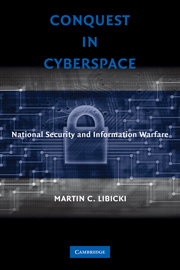Book contents
- Frontmatter
- Contents
- List of Figures
- Acknowledgments
- 1 Introduction
- 2 Hostile Conquest as Information Warfare
- 3 Information Warfare as Noise
- 4 Can Information Warfare Be Strategic?
- 5 Information Warfare Against Command and Control
- 6 Friendly Conquest in Cyberspace
- 7 Friendly Conquest Using Global Systems
- 8 Retail Conquest in Cyberspace
- 9 From Intimacy, Vulnerability
- 10 Talking Conquest in Cyberspace
- 11 Managing Conquest in Cyberspace
- Appendix A Why Cyberspace Is Likely to Gain Consequence
- Index
3 - Information Warfare as Noise
Published online by Cambridge University Press: 05 June 2012
- Frontmatter
- Contents
- List of Figures
- Acknowledgments
- 1 Introduction
- 2 Hostile Conquest as Information Warfare
- 3 Information Warfare as Noise
- 4 Can Information Warfare Be Strategic?
- 5 Information Warfare Against Command and Control
- 6 Friendly Conquest in Cyberspace
- 7 Friendly Conquest Using Global Systems
- 8 Retail Conquest in Cyberspace
- 9 From Intimacy, Vulnerability
- 10 Talking Conquest in Cyberspace
- 11 Managing Conquest in Cyberspace
- Appendix A Why Cyberspace Is Likely to Gain Consequence
- Index
Summary
Information at rest can be destroyed if its owners have failed to back it up. Information in motion can also be halted by attacks on communications system. There is yet one more way to destroy information, and that is by doing so indirectly. The bits, as it were, are untouched. But the credibility of the information is ruined by adding false information to it to the point where the victim must choose between misinformation (believing what is not true) or disinformation (being unable to believe what is true). Here, we argue, is the essential character of information warfare, something entirely consistent with the theory of information.
Information theory, for its part, was invented nearly sixty years ago by Claude Shannon asking how much information can be extracted from a signal. In digital terms, if every bit is guaranteed to arrive error-free, then every bit can contain information. If some known percentage of bits is randomly flipped, the amount of reliable information in the bit-stream would be reduced. There are techniques (such as trellis encoding) that can, by adding bits, increase the confidence that one can recover the original signal, but they reduce the ratio of signal to bits transmitted, cannot restore 100 percent confidence, and require that the distribution of flipped bits be random and their expected error rate be more or less known. Randomly flipped bits can be seen as noise.
- Type
- Chapter
- Information
- Conquest in CyberspaceNational Security and Information Warfare, pp. 50 - 72Publisher: Cambridge University PressPrint publication year: 2007



